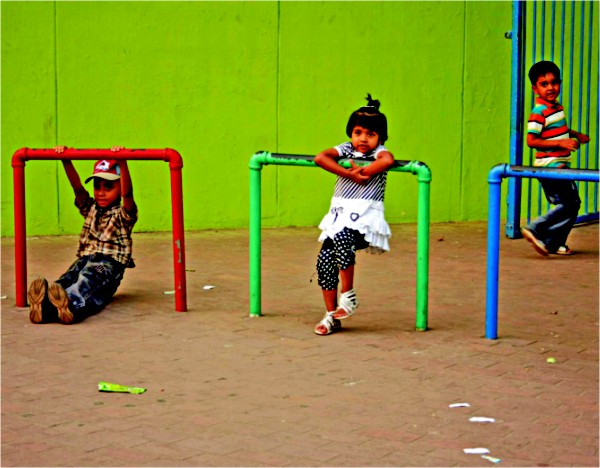

Photo: Amdadul Huq/Driknews
Our children, our city
Dr. M. Zakiul Islam
Rubel, an eleven year old, replied, “Not a single minute” when he was asked, “How many minutes he usually spends outdoors?” We were conducting a survey on the school going children of 8 to 12 years of age living in Dhaka. My heart was breaking each time children were asked this question about their time spent outdoors. Because most of the time the answer was obvious, same as Rubel's.
Children living in Dhaka do not have the opportunity to go outdoors and play, which I am sure you (assuming you are over thirty) had during your childhood. Children love to go outdoors. This is universal. Plenty of studies conducted on this subject concluded that children prefers outdoors to indoors. However, in the name of urban growth we have transformed each of our houses into a prison for our children. Relentlessly children are spending time indoors without going outdoors on their own. The percentage is even higher for girls when compared with boys.
Let me share with you some of the shocking data that we have collected through our study conducted at Dhaka. About one-fifth of the children have no friends in his or her neighborhood. Do you remember how many friends you had when you were 11 or 12? I had more than ten close friends for sure. 37% children of the study do not spent one minute outdoors. About one-quarter of our children do not know even one adult in the neighborhood other than his own family. I still remember Mr. Kashem the corner store keeper, and the person who used to fix my bike for free. Only one-tenth of the parents of Dhaka feel that their neighborhood is 'very safe' for their children to roam around freely while one-third of the parents think that the neighborhood is unsafe. One-third! What kind of city are we creating where one third parents feel that their respective neighborhood is unsafe for their children?
However, it has been more than twenty years since Bangladesh have ratified the Convention on the Rights of Child (CRC). This is an international, legally binding instrument to incorporate children's rights. We committed that we would do our best for the betterment of our future generation's lives. Article 31 of the CRC clearly states, “Parties recognize the right of the child to rest and leisure, to engage in play and recreational activities appropriate to the age of the child and to participate freely in cultural life and the arts.” In order to fulfill this right, children need places to play within their neighborhoods. However, we have failed to provide such places for our children in Dhaka. We failed to create Dhaka as a child-friendly city.
One of the indicators of child-friendliness of a city is independent mobility. Independent mobility is the measure of the distance that a child can travel without any adult's assistance. Do you remember how you used to wander around the neighborhood during the late afternoon all by yourself when you were 12 years old? You could because you had higher independent mobility. The survey that we completed over one hundred children shows that one-fifth of the school going children of Dhaka do not have even one foot of independent mobility. The independent mobility of a girl is less when compared with a boy of the same age. Moreover, the independent mobility of girls reduces as she grows from ten to twelve years old. The average independent mobility of a ten, eleven, and a twelve year old girl is 980, 475, and 425 feet respectively. World is becoming smaller, indeed, at least for our girls living in Dhaka!
Research shows that Independent mobility is essential for proper child development both mentally and physically. Apart from creating self-confidence, independent mobility is associated with sense of loneliness, fear of crime, and sense of community. A child with more independent mobility is more likely to have less sense of loneliness and fear of crime than a child with no independent mobility. We have to remember that here, we are not talking about only few children with more sense of loneliness and less sense of community, but we are dealing about one fifth of our future generation with no mobility at all.
 |
Photo: Iqbal Ahmed/Driknews |
We will not be able to change the situation of children living in Dhaka overnight. We cannot have playgrounds in each neighborhood as we have already imprudently crammed up every possible empty spaces of Dhaka. However, we can follow what others have done in their respective cities in similar situation. In many neighborhoods of European cities certain roads are converted to dead-end during particular time period and making it safer for children to roam around. Many European countries have followed this idea and converted residential streets as outdoors for their children. The project is known as Woonerven, which have created safe residential streets where children can play. We still have plenty of opportunities to do this. We can convert many of our neighborhood narrow streets as dead-end at least on weekends or during certain hours when our children returns from school. Children along with adults will be able to use this safe street. Our study has shown that through streets is good for car as car can cover longer distance with lesser time. However, we have also observed that children who live on dead-end streets spend more time outdoors than the children who lives on a through street. Because through street allows more traffic and more stranger entering the neighborhood which discourage parents to grant more latitude to his or her child to go outdoors.
Let us do something for our children for their well-being. Let us make each of our neighborhoods safe for our children to roam around. Let Rubel play outdoors as much as he wants as you did when you are at his age.
The author is Assistant Professor, Department of Architecture, BUET, Dhaka.